
Part Four:Writing and Translation>>Translation Return Knowing About Translation 定语从句分限制性和非限制性两种。限制性 定语从句与其所修饰的先行词紧紧相连,与其关 系密切,没有它,主句的意义不完整;非限制性 限制性定语从句的翻译 定语从句与先行词之间有逗号隔开,作为补充性 叙述或者说明。在翻译限制性定语从句之前,首 先要辨明引导从句的关系代词或副词,如that, which,when,as,然后要判断由这些词引导的 从句所修饰的先行词。限制性定语从句的翻译方 法主要有以下几种:
Part Four: Writing and Translation >> Translation 限 制 性 定 语 从 句 的 翻 译 定语从句分限制性和非限制性两种。限制性 定语从句与其所修饰的先行词紧紧相连,与其关 系密切,没有它,主句的意义不完整;非限制性 定语从句与先行词之间有逗号隔开,作为补充性 叙述或者说明。在翻译限制性定语从句之前,首 先要辨明引导从句的关系代词或副词,如 that, which,when,as,然后要判断由这些词引导的 从句所修饰的先行词。限制性定语从句的翻译方 法主要有以下几种: Knowing About Translation
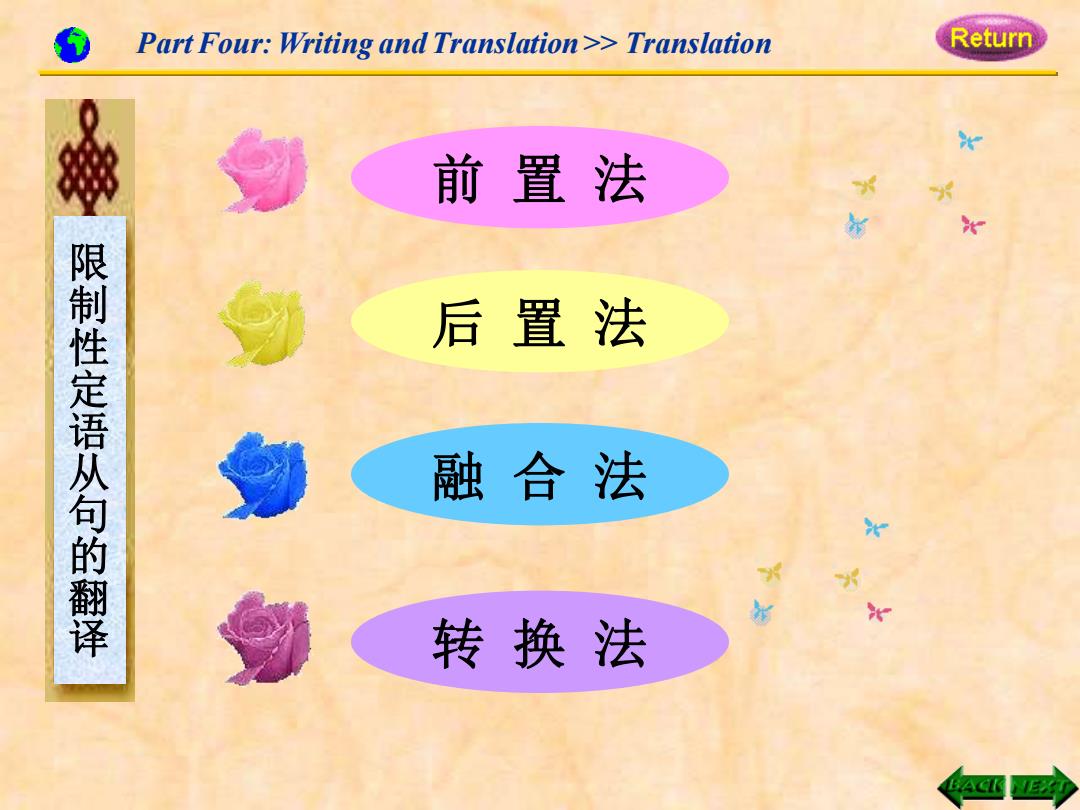
Part Four:Writing and Translation>>Translation Return 前置法 限制性定语从句的翻译 后置法 融合法 为 转换法
前 置 法 限 制 性 定 语 从 句 的 翻 译 后 置 法 融 合 法 转 换 法 Part Four: Writing and Translation >> Translation
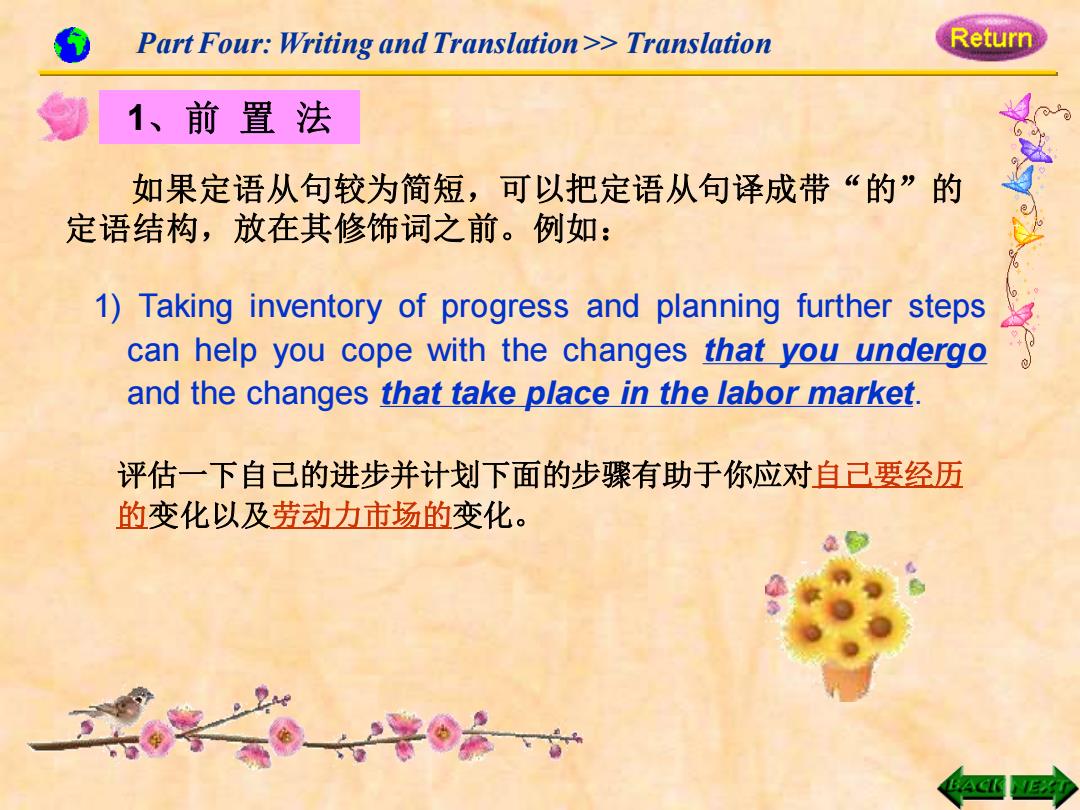
Part Four:Writing and Translation>>Translation Return 1、前置法 如果定语从句较为简短,可以把定语从句译成带“的”的 定语结构,放在其修饰词之前。例如: 1)Taking inventory of progress and planning further steps can help you cope with the changes that you undergo and the changes that take place in the labor market. 评估一下自己的进步并计划下面的步骤有助于你应对自己要经历 的变化以及劳动力市场的变化
1、前 置 法 如果定语从句较为简短,可以把定语从句译成带“的”的 定语结构,放在其修饰词之前。例如: 1) Taking inventory of progress and planning further steps can help you cope with the changes that you undergo and the changes that take place in the labor market. 评估一下自己的进步并计划下面的步骤有助于你应对自己要经历 的变化以及劳动力市场的变化。 Part Four: Writing and Translation >> Translation

Part Four:Writing and Translation>>Translation Return 2)Today,growing numbers of men and women are changing careers or getting second starts in careers that have greater appeal to them. 如今,越来越多的男男女女在变换职业,或者重新开始一份对他们 更有吸引力的职业。 3)Law offers us our best hope of overcoming the differences that prevail in the world. 法律使我们最有希望去克服世界上普遍存在的分歧
2) Today, growing numbers of men and women are changing careers or getting second starts in careers that have greater appeal to them. 如今,越来越多的男男女女在变换职业,或者重新开始一份对他们 更有吸引力的职业。 3) Law offers us our best hope of overcoming the differences that prevail in the world. 法律使我们最有希望去克服世界上普遍存在的分歧。 Part Four: Writing and Translation >> Translation
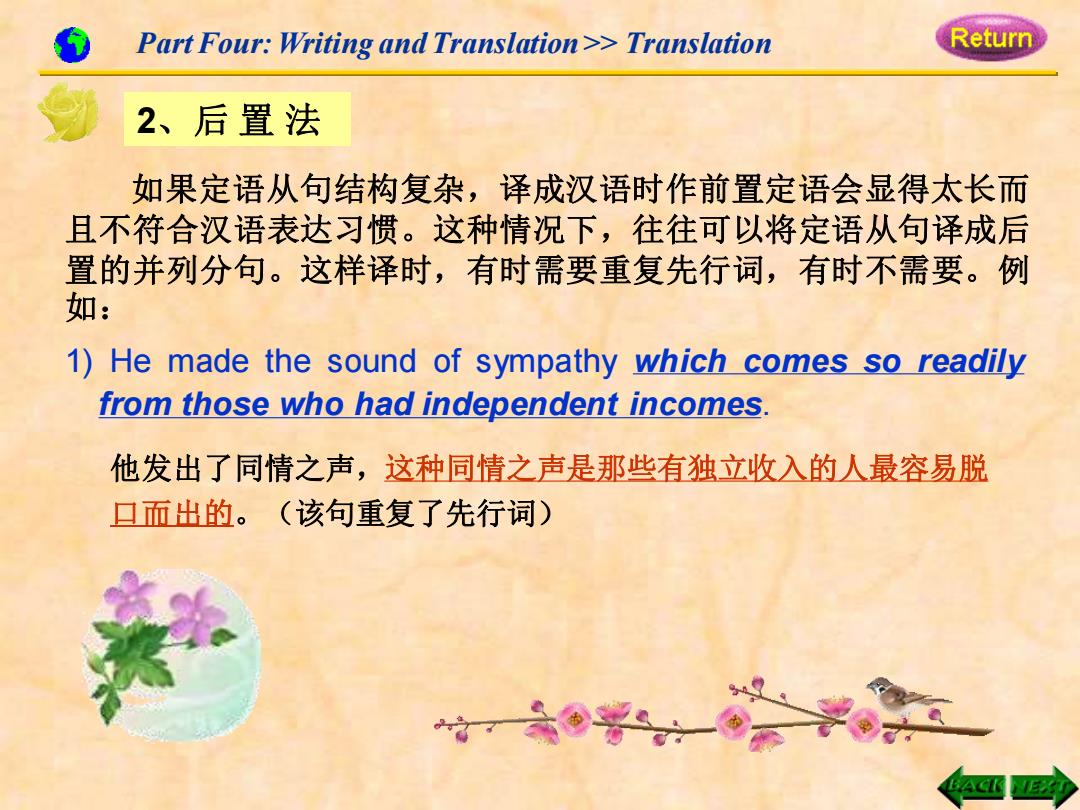
Part Four:Writing and Translation>>Translation Return 2、后置法 如果定语从句结构复杂,译成汉语时作前置定语会显得太长而 且不符合汉语表达习惯。这种情况下,往往可以将定语从句译成后 置的并列分句。这样译时,有时需要重复先行词,有时不需要。例 如: 1)He made the sound of sympathy which comes so readily from those who had independent incomes. 他发出了同情之声,这种同情之声是那些有独立收入的人最容易脱 口而出的。(该句重复了先行词)
2、后 置 法 如果定语从句结构复杂,译成汉语时作前置定语会显得太长而 且不符合汉语表达习惯。这种情况下,往往可以将定语从句译成后 置的并列分句。这样译时,有时需要重复先行词,有时不需要。例 如: 1) He made the sound of sympathy which comes so readily from those who had independent incomes. 他发出了同情之声,这种同情之声是那些有独立收入的人最容易脱 口而出的。(该句重复了先行词) Part Four: Writing and Translation >> Translation
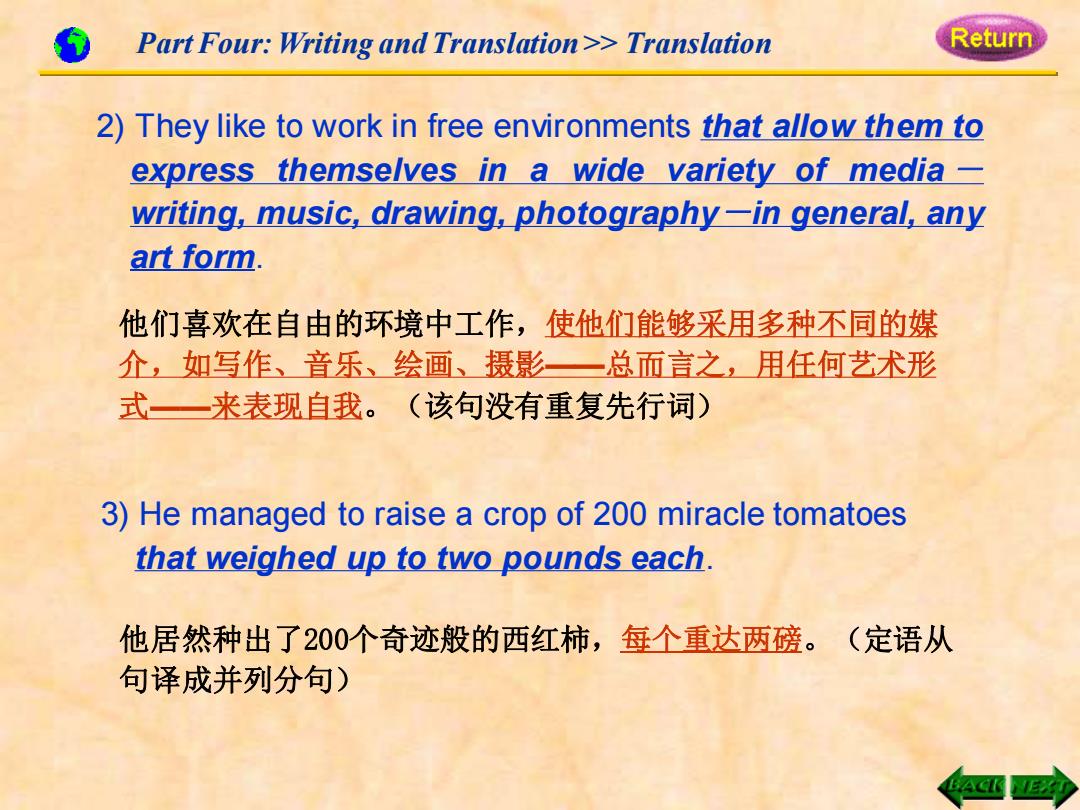
Part Four:Writing and Translation>>Translation Return 2)They like to work in free environments that allow them to express themselves in a wide variety of media- writing,music,drawing,photography-in general,any art form. 他们喜欢在自由的环境中工作,使他们能够采用多种不同的媒 介,如写作、音乐、绘画、摄影一总而言之,用任何艺术形 式一来表现自我。(该句没有重复先行词) 3)He managed to raise a crop of 200 miracle tomatoes that weighed up to two pounds each. 他居然种出了200个奇迹般的西红柿,每个重达两磅。(定语从 句译成并列分句)
2) They like to work in free environments that allow them to express themselves in a wide variety of media- writing, music, drawing, photography-in general, any art form. 他们喜欢在自由的环境中工作,使他们能够采用多种不同的媒 介,如写作、音乐、绘画、摄影——总而言之,用任何艺术形 式——来表现自我。(该句没有重复先行词) 3) He managed to raise a crop of 200 miracle tomatoes that weighed up to two pounds each. 他居然种出了200个奇迹般的西红柿,每个重达两磅。(定语从 句译成并列分句) Part Four: Writing and Translation >> Translation
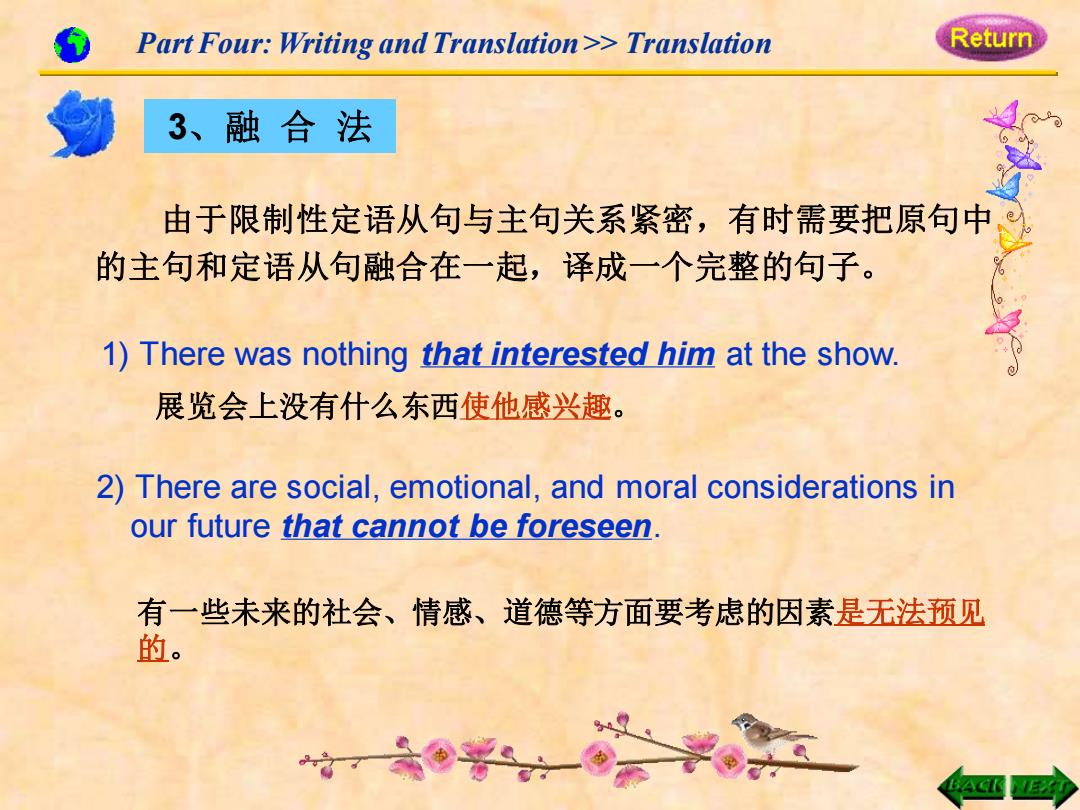
Part Four:Writing and Translation>>Translation Return 3、融合法 由于限制性定语从句与主句关系紧密,有时需要把原句中 的主句和定语从句融合在一起,译成一个完整的句子。 1)There was nothing that interested him at the show. 展览会上没有什么东西使他感兴趣。 2)There are social,emotional,and moral considerations in our future that cannot be foreseen. 有一些未来的社会、情感、道德等方面要考虑的因素是无法预见 的
3、融 合 法 由于限制性定语从句与主句关系紧密,有时需要把原句中 的主句和定语从句融合在一起,译成一个完整的句子。 1) There was nothing that interested him at the show. 展览会上没有什么东西使他感兴趣。 2) There are social, emotional, and moral considerations in our future that cannot be foreseen. 有一些未来的社会、情感、道德等方面要考虑的因素是无法预见 的。 Part Four: Writing and Translation >> Translation

Part Four:Writing and Translation >Translation Return 3)Students who fail to think about the implications of their career choices often engage in rationalization (deceiving oneself with self-satisfying but incorrect explanations for one's behavior)or procrastination(putting off or delaying). 有些学生没有考虑到职业抉择会产生的影响,往往采取文过饰非 (对自己的行为所作的解释虽能自我满足但却是错误的,以此来 欺骗自己)或者拖延(推迟或耽搁)的态度
3) Students who fail to think about the implications of their career choices often engage in rationalization (deceiving oneself with self-satisfying but incorrect explanations for one’s behavior) or procrastination (putting off or delaying). 有些学生没有考虑到职业抉择会产生的影响,往往采取文过饰非 (对自己的行为所作的解释虽能自我满足但却是错误的,以此来 欺骗自己)或者拖延(推迟或耽搁)的态度。 Part Four: Writing and Translation >> Translation

Part Four:Writing and Translation>>Translation Return 4、转换法 有些限制性定语从句兼有其他语法结构的功能,如状语从句 的功能,在意义上与主句有状语关系,说明原因、结果、目 的、让步或假设等关系。翻译时可以分析原文主句和从句之 间的逻辑关系,然后译成相应的汉语。 1)He lived his life apart from the workers on whose skill he depended. 他不跟工人们生活在一起,尽管他依赖他们的技能。(译成让 步分句) 2)He wishes to write an article that will attract public attention to the matter. 他想写一篇文章,以便能引起公众对这件事的注意。(译成表 示目的分句)
4、转 换 法 有些限制性定语从句兼有其他语法结构的功能,如状语从句 的功能,在意义上与主句有状语关系,说明原因、结果、目 的、让步或假设等关系。翻译时可以分析原文主句和从句之 间的逻辑关系,然后译成相应的汉语。 1) He lived his life apart from the workers on whose skill he depended. 他不跟工人们生活在一起,尽管他依赖他们的技能。(译成让 步分句) 2) He wishes to write an article that will attract public attention to the matter. 他想写一篇文章,以便能引起公众对这件事的注意。(译成表 示目的分句) Part Four: Writing and Translation >> Translation
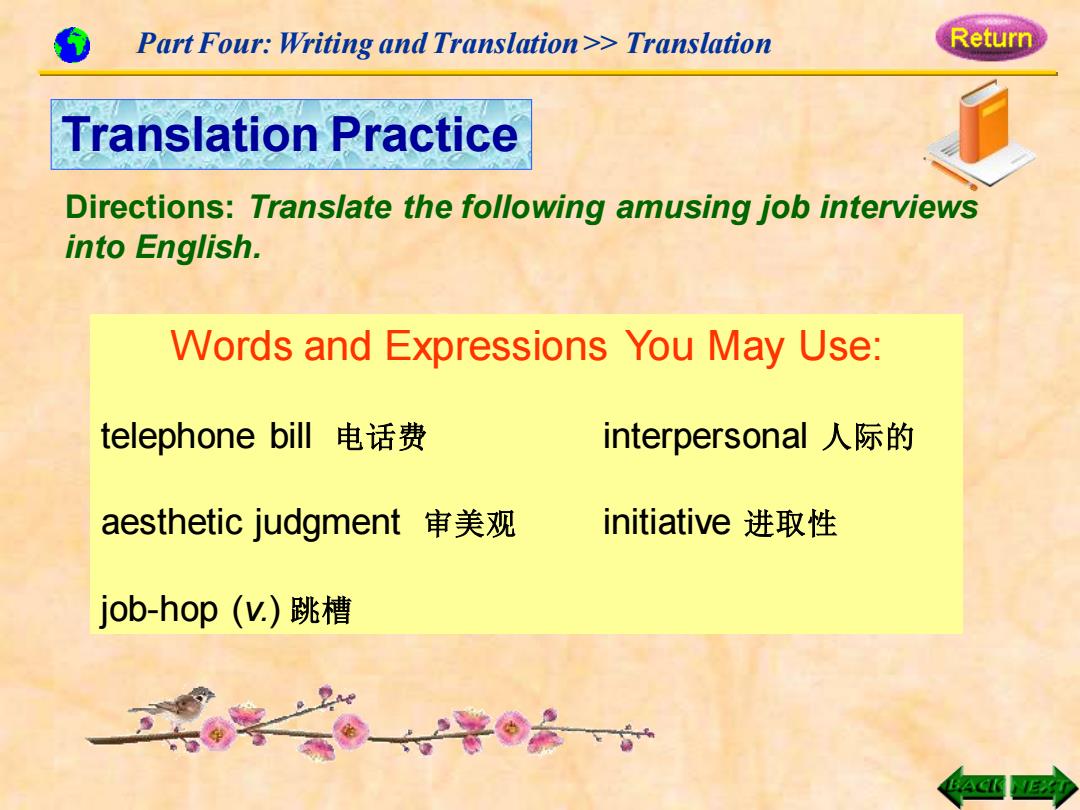
Part Four:Writing and Translation >Translation Return Translation Practice Directions:Translate the following amusing job interviews into English. Words and Expressions You May Use: telephone bill电话费 interpersonal人际的 aesthetic judgment审美观 initiative进取性 job-hop()跳槽
Translation Practice Directions: Translate the following amusing job interviews into English. Words and Expressions You May Use: telephone bill 电话费 interpersonal 人际的 aesthetic judgment 审美观 initiative 进取性 job-hop (v.) 跳槽 Part Four: Writing and Translation >> Translation